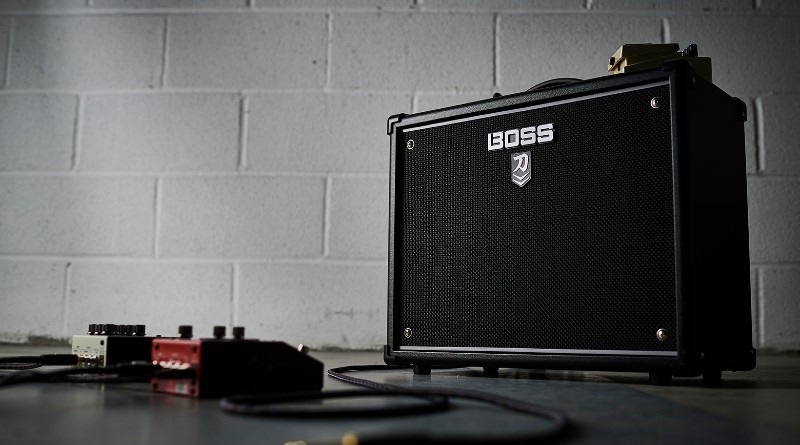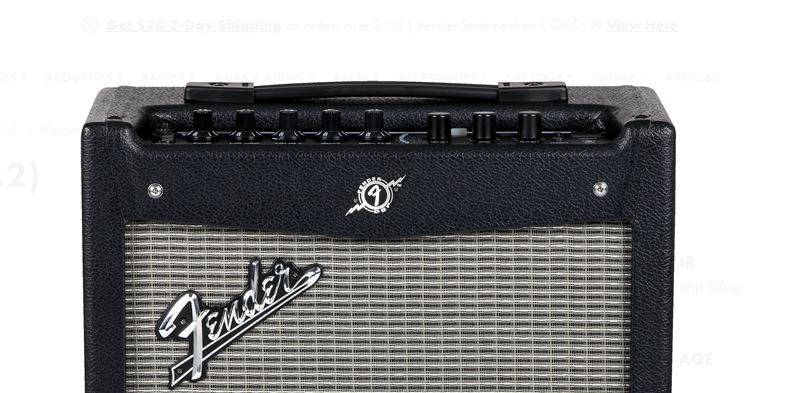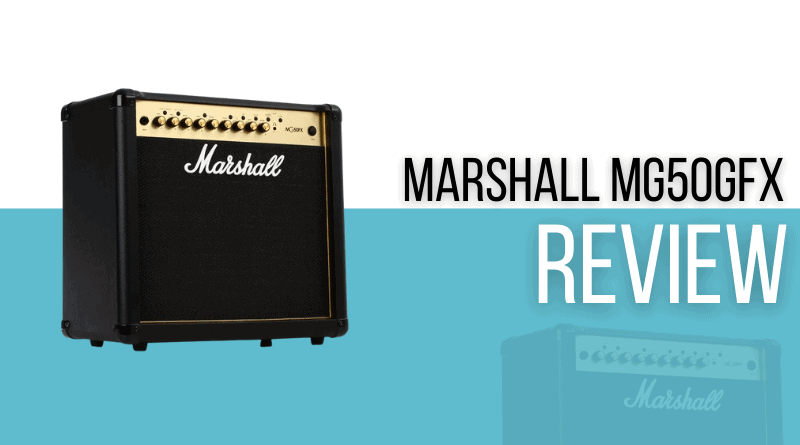In all of rock ‘n roll history, one brand of amplifiers has held its own, and became the most recognisable amplifier brand in history: Marshall.
From the legendary Marshall Plexi to the ever so versatile JCM 800, Marshall has made its mark in music history.
While Marshall is known for making tube amplifiers, they have dipped their toes into solid state technology such as the classic Marshall Valvestate, which featured a tube preamp section and a solid state poweramp.
The MG50GFX represents the latest in Marshall’s all solid state line, and if you’re looking for a classic Marshall tone at combo prices, it’s not a bad option.
Read more about our review process.
Contents
Marshall MG50GFX: Who is it for?
The MG line was designed for those who wanted the true Marshall sound, without the hassle that tube amplifiers bring (hassles such as high volumes, potential damage to the tubes, and amp weight).
The MG comes in different sizes to accommodate different players’ needs. For this review, we’ll focus on the MG50FX, which is the medium sized version of the amp.
The MG50FX is plenty loud for practise and small gigs, and can work with a medium loud band. For more volume or more headroom you should look for the larger models. This amp is loud enough for home practise, and can go from very quiet to fairly loud without losing tonal quality (any louder and you’ll want to look at some soundproofing curtains).
Marshall MG50GFX: Appearance
There’s no doubt the MG50GFX is a Marshall. Gold face and knobs, black grill cloth, and the white logo displaying the legendary brand name synonymous with rock. The amp looks similar to most other amps that Marshall has made, and for a good reason, as the appearance of the amps is one of the things that made Marshall into the musical icon that it is today. And even though Marshall’s most glorious days are technically over, the classic look will remain just that, a classic. And so it is good that this amp holds true to that tradition
The MG50GFX doesn’t have any spectacularly different aesthetic features to most other Marshall Amps, other than the large MG icon displayed on the older models. Marshall actually also did a limited run with a silver hardware look instead of the classic gold. The altered look is the only difference between this and the regular production models.
The amp is a square box with faux-tolex and plastic corner pieces. This makes it look the part, but not feel the part. From a distance it’s hard to tell that this is a budget Marshall, but the closer you get to it, the more apparent this becomes.
It does feature a carry handle, which is nice for when you want to carry around the amp from gig to gig. This comes standard on basically any amp, but it’s still a nice feature to have.
All the gold hardware is made out of plastic, which doesn’t feel as fancy as the metal on the ‘larger’ Marshalls. The buttons have a red or green light that lights up whenever the button is engaged.
Marshall MG50GFX: Features
The MG is very much feature packed, which is a selling point of the amp. It includes 4 channels (all analogue solid state technology) that are completely programmable and can be saved as presets. The four channels are clean. crunch, OD1, and OD2.
Two effects can be engaged simultaneously, such as reverb and chorus, or delay and octaver. The amp includes a wide array of modulation and time based effects, which is a nice feature.
These effects are not included in the older version of the MG. The newer versions are called the MG FX, but for simplicity’s sake, I’ll refer to the amps as MG. The only effects that are included in the older versions are the reverb and delay. The amp features a tap tempo button for the delay. To access all the effects, Marshall sells a separate programmable 4-button footswitch.
As with most solid state amps, the MG includes a headphone/line output for silent practise or direct recording, and a MP3/line input for playing along to songs or backing tracks without needing a separate loudspeaker for the track or song.
Something interesting the amp includes is a ‘damping’ feature. This changes the character of the amp from a ‘classic feel’ to a ‘modern response’. This is to simulate the way the amp responds to your playing, and models older amps like the Plexi and the JCM for the ‘classic feel’, and the DSL and Valvestate amps for the ‘modern response’. This makes the amp more versatile. This same button can be used to switch between manual mode, and the user presets.
The amp also features an external effects loop for external effects pedals.
Marshall MG50GFX: Controls
The amps controls are dead simple and work like any other amp. But for those unfamiliar, this is what they do:
On the face of the MG50GFX, the knobs and buttons work as follows:
- Gain: Determines the amount of volume that goes into the preamp. Turning this up will increase harmonic overtones (also known as distortion), and turning it down will make the sound clean again.
- Clean/Crunch & OD1/OD2: These buttons determine which channel the amp is set to. Every channel has its own character and gain staging. Clean is the cleanest channel with the least amount of distortion, whereas the OD2 steps into high gain territory.
- Bass/Middle/Treble: This is the EQ section of the amp. This determines the frequencies that the amp boosts and cuts.
- Reverb: The button turns the reverb on and off, and the knob determines the type of reverb and the amount of it.
- Volume: Determines the volume of the channel.
- FX: The button turns the effects on and off, and the wheel determines the kind and amount of the effect on the sound.
- Tap: Sets the speed of the delay.
- Delay: Determines the type and amount of delay on the sound.
- External FX: Turns the effects loop on and off.
- Master: Sets the master volume.
- Damping: Sets the damping mode, and if held for longer than two seconds turns off the presets and switches the amp into manual mode.
- Store: Saves the current setting to the channel’s preset.
Easy to use controls are crucial for an amp at this price point, as it doesn’t discourage beginners from learning how it works. The controls are all laid out very comprehensible and not overly complicated.
Marshall MG50GFX: Performance
Arguably, the most crucial part of any piece of musical gear is how it sounds. This is unfortunately where most of the hate towards the MG comes from. People tend to say that the clean sounds are adequate and work well with pedals, but the gain sounds are nothing to write home about.
The problem lies mostly in the way the distortion is created. Normally, distortion appears when tubes are driven beyond their capabilities, thus compressing the signal and creating harmonic overtones.
But when an amp doesn’t have tubes, the distortion comes from the solid state technology inside. This type of distortion is often described as shrill, thin, and digital sounding. In the modern day and age, solid state technology has advanced to the point where it can create amp-like sounds. But the MG unfortunately is not this far.
The MG doesn’t sound bad, it just doesn’t sound the way most guitarists desire. They see Marshall on the front and expect it to sound like a JCM 900, but when they turn it on and turn it up, it just doesn’t.
The speaker doesn’t help either. It sounds bright and somewhat shrill, with lots of treble and not a lot of bass. Even though it’s a 12” speaker, it sounds like a much smaller one.
But with lots of tweaking (and good technique) it’s absolutely possible to get a great sound out of it, especially with an upgraded speaker.
But most of this doesn’t matter for a beginner, which is what this amp is marketed towards. They just want the amp to make the sounds they have in their head, and aren’t looking for the most stellar tones ever. So in that case, the amp performs perfectly.
Other amps to consider
Boss Katana 50 MkII

This is a no-brainer. There is a good reason this amp has gained a bit of cult-following. Everything from the features to the sound is good, and it’s extremely affordable as well. It’s absolutely loud enough for most purposes. This is the amp that kills all other amps under $300. Loading in patches and sharing them with other users is super simple, and with the new capabilities of the MkII, the possibilities are endless with this.
Fender Mustang

Coming in various sizes and models, the Fender Mustang is a great choice for those who want just a bit more features for a similar price. Fender and Marshall have become iconic rivals, but both have their own thing that makes them unique from each other.
Marshall Code
For those who really want a solid-state Marshall but are unhappy with the MG, the Code luckily exists. The Code is a more modern modeling amp like the aforementioned amps. It simulates classic Marshall amps rather than trying to be its own thing.
Final thoughts on the Marshall MG50GFX
The most important aspects of the Marshall MG50GFX:
- Easy to use
- Feature packed
- Classic look and feel
- Lacking sound but great for the purpose
- Better alternatives within the same price range exist
So, does the Marshall MG do what it’s supposed to? Yes! And that’s what really matters here. Is it absolutely the best choice out there? No. Is it worth the money? Yes! Are there amps with better value (both retail and resell) Yes!



